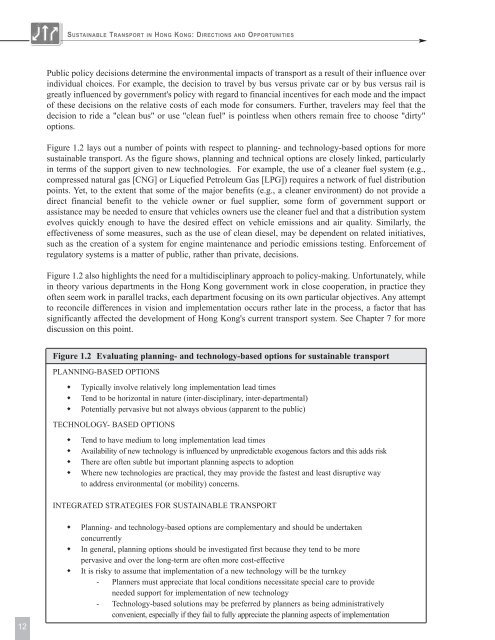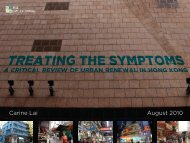Untitled - Civic Exchange
Untitled - Civic Exchange
Untitled - Civic Exchange
You also want an ePaper? Increase the reach of your titles
YUMPU automatically turns print PDFs into web optimized ePapers that Google loves.
SUSTAINABLE TRANSPORT IN HONG KONG: DIRECTIONS AND OPPORTUNITIES<br />
Public policy decisions determine the environmental impacts of transport as a result of their influence over<br />
individual choices. For example, the decision to travel by bus versus private car or by bus versus rail is<br />
greatly influenced by government's policy with regard to financial incentives for each mode and the impact<br />
of these decisions on the relative costs of each mode for consumers. Further, travelers may feel that the<br />
decision to ride a "clean bus" or use "clean fuel" is pointless when others remain free to choose "dirty"<br />
options.<br />
Figure 1.2 lays out a number of points with respect to planning- and technology-based options for more<br />
sustainable transport. As the figure shows, planning and technical options are closely linked, particularly<br />
in terms of the support given to new technologies. For example, the use of a cleaner fuel system (e.g.,<br />
compressed natural gas [CNG] or Liquefied Petroleum Gas [LPG]) requires a network of fuel distribution<br />
points. Yet, to the extent that some of the major benefits (e.g., a cleaner environment) do not provide a<br />
direct financial benefit to the vehicle owner or fuel supplier, some form of government support or<br />
assistance may be needed to ensure that vehicles owners use the cleaner fuel and that a distribution system<br />
evolves quickly enough to have the desired effect on vehicle emissions and air quality. Similarly, the<br />
effectiveness of some measures, such as the use of clean diesel, may be dependent on related initiatives,<br />
such as the creation of a system for engine maintenance and periodic emissions testing. Enforcement of<br />
regulatory systems is a matter of public, rather than private, decisions.<br />
Figure 1.2 also highlights the need for a multidisciplinary approach to policy-making. Unfortunately, while<br />
in theory various departments in the Hong Kong government work in close cooperation, in practice they<br />
often seem work in parallel tracks, each department focusing on its own particular objectives. Any attempt<br />
to reconcile differences in vision and implementation occurs rather late in the process, a factor that has<br />
significantly affected the development of Hong Kong's current transport system. See Chapter 7 for more<br />
discussion on this point.<br />
Figure 1.2 Evaluating planning- and technology-based options for sustainable transport<br />
PLANNING-BASED OPTIONS<br />
• Typically involve relatively long implementation lead times<br />
• Tend to be horizontal in nature (inter-disciplinary, inter-departmental)<br />
• Potentially pervasive but not always obvious (apparent to the public)<br />
TECHNOLOGY- BASED OPTIONS<br />
• Tend to have medium to long implementation lead times<br />
• Availability of new technology is influenced by unpredictable exogenous factors and this adds risk<br />
• There are often subtle but important planning aspects to adoption<br />
• Where new technologies are practical, they may provide the fastest and least disruptive way<br />
to address environmental (or mobility) concerns.<br />
INTEGRATED STRATEGIES FOR SUSTAINABLE TRANSPORT<br />
12<br />
• Planning- and technology-based options are complementary and should be undertaken<br />
concurrently<br />
• In general, planning options should be investigated first because they tend to be more<br />
pervasive and over the long-term are often more cost-effective<br />
• It is risky to assume that implementation of a new technology will be the turnkey<br />
- Planners must appreciate that local conditions necessitate special care to provide<br />
needed support for implementation of new technology<br />
- Technology-based solutions may be preferred by planners as being administratively<br />
convenient, especially if they fail to fully appreciate the planning aspects of implementation

















